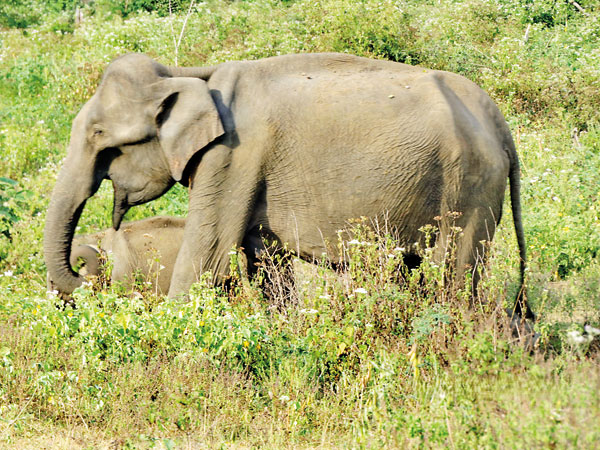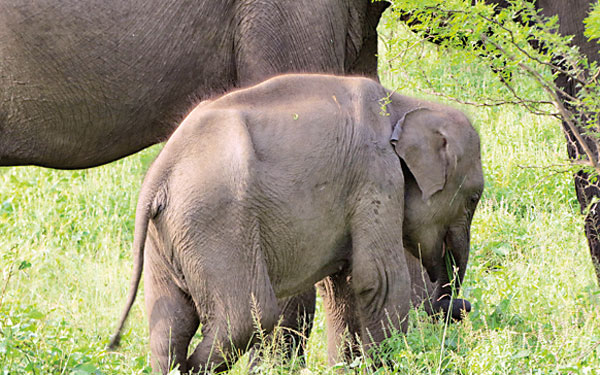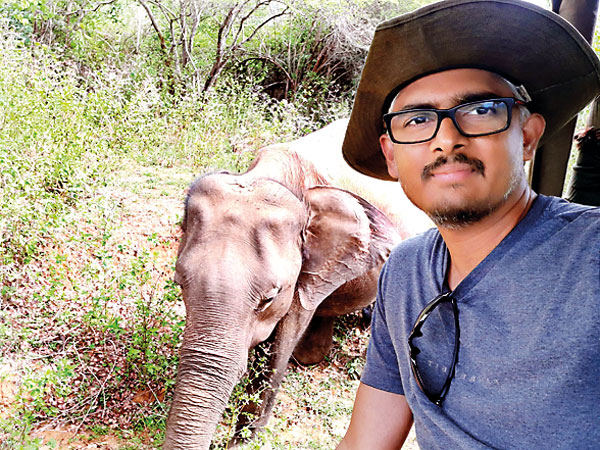News
Drastic drop in wild elephant numbers at Uda Walawe National Park
View(s):- Conservation Biologist Dr. Ashoka Ranjeewa zeroes in on the cause as lack of grasslands and suggests solutions to make them thrive again
By Kumudini Hettiarachchi
There has been a drastic drop in wild elephant numbers in the Uda Walawe National Park in a short span of 10 years, an extensive research has found.
The elephant population has dropped by a huge 50% (half), lamented Conservation Biologist Dr. Ashoka Ranjeewa who has been in and out of the park for over 20 years.
He has been able to individually identify 700 elephants with around 400-600 using the park, whereas in a study conducted in 2007-2008 by Dr. Shermin de Silva as the lead researcher and published in 2011 in which he too participated, the count had been 800-1,200 elephants.

An adult female with temporal (the temple region of the head) depression and exposed scapula (shoulder blade) with other protruding bones, indicating a poor body condition. Pix by Dr. Ashoka Ranjeewa
Dr. Ranjeewa’s recent study (2016-2019) titled ‘The behaviour of male Asian elephants in different life stages in Uda Walawe’ which covers numerous angles, is his doctoral thesis at the Faculty of Science, University of Colombo.
Before delving into the loss of elephants at the park and what could be done to stymie this, he explains how he categorised the elephants to determine their population structure.
Juveniles, both male and female, went into 4 categories. These categories were determined by comparing their height to that of an adult female.
Category 1 (youngest group) – those below one-year-old
Category 2 – those between 1 to 3 years
Category 3 – those between 3 to six years
Category 4 (oldest group) – those between 6 to 10 years
Adult males were categorised into the following groups, once again in comparison to the height of an adult female:
Sub-adults – in the age-group 10-15 years. Their height was equal to the height of an adult female
Young adults – in the age-group 15-25 years. They were taller than adult females and sub-adults but shorter than mature adults.
Mature adults – above 25 years. They were the tallest when compared to all the other groups and had well-developed secondary sexual features such as a prominent frontal dome and also broad nasal prominence.
Meanwhile, reproductively-active females were defined as adults. These included those with dependent calves and/or with full mammary glands.

A close-up of a juvenile between 1-3 years old with prominent scapula (shoulder blade), ribs, flank and pelvic bones, indicating a poor body condition
The study covers elephant numbers in the park, their demographics, the male-female population structure, the group size and also calf survival. The elephant population estimates had been calculated on the capture-recapture methodology.
The huge drop in elephant numbers, Dr. Ranjeewa attributes to the loss of habitat. The NP had grasslands, with an abundance of elephant grass relished by the elephants which, gradually due to unmanaged ecological succession, has changed into shrubs or mixed forest and finally mature forest.
“This has a massive impact on wild elephants,” he reiterates, pointing out that with their main food source vanishing, elephants have been compelled to go in search of food.
According to this researcher, the results are disturbing – with the same species in competition with each other for food, some would leave the NP. Those who go out face the danger of dying due to various reasons including the human-elephant conflict, while some would be hindered from leaving the NP due to the electric fences and could be assumed to have died of starvation.

Dr. D.G. Ashoka Ranjeewa
This is while two vulnerable groups would be the newborns and the elderly, he says, spotlighting how the very young may face malnourishment and die due to their mothers not producing adequate milk for lack of food. To face these critical conditions, there would also be a natural large inter-calf birth interval (the birth interval between calves of a particular mother). At the other end of the spectrum, the not-so-robust elderly may also be unable to compete for food and succumb to the natural law of the jungle.
These reasons, especially a combination, would lead to an elephant population drop at this NP, he says, predicting a gloomy future with elephant group sizes decreasing and the body conditions of those who survive deteriorating, if no action is taken to redress the situation.
While highlighting the sad plight of Uda Walawe’s elephants, Dr. Ranjeewa is grateful for the support and collaboration provided by Prof. Devaka Weerakoon and Dr. Prithiviraj Fernando in the conduct of his study. He appreciates the Department of Wildlife Conservation for giving him permission to do the study there and the National Science Foundation for funding the project.
| Habitat restoration of Uda Walawe the need of the hour Not just forecasting doom and gloom about the unfortunate situation of a decline in the elephant population at Uda Walawe, Dr. Ashoka Ranjeewa makes invaluable suggestions on how to stem this trend. On what can be done, he says: Research on habitat restoration supported by the guardians of Uda Walawe, the Department of Wildlife Conservation, is essential to get the right direction based on science. Long-term monitoring is also vital to prevent the sensitive ecosystem balance going awry at Uda Walawe. | |
The best way to say that you found the home of your dreams is by finding it on Hitad.lk. We have listings for apartments for sale or rent in Sri Lanka, no matter what locale you're looking for! Whether you live in Colombo, Galle, Kandy, Matara, Jaffna and more - we've got them all!

